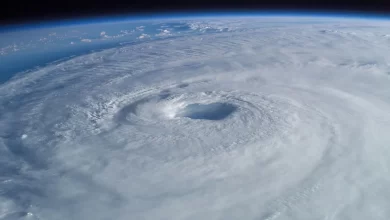A tsunami is a natural disaster that is a series of fast-moving waves in the ocean caused by powerful earthquakes, volcanic eruptions, landslides, or simply an asteroid or a meteor crash inside the ocean. A tsunami has a very long wavelength. It can be hundreds of kilometers long. Usually, a tsunami starts suddenly.
- A tsunami is a series of waves caused by earthquakes, undersea volcanic eruptions, or a landslide.
- The word tsunami is derived from two words of Japanese. Tsu means port or harbor whereas, Nami means waves.
- A tsunami occurs when an earthquake or a volcanic eruption pushes the part of the seafloor up or down. This changes the height of water beneath, which results in tsunamis.
- The largest tsunami wave ever recorded happened on a cool July night in 1958. A 1,720-foot tsunami towered over Lituya Bay, a quiet fjord in Alaska after an earthquake rumbled 13 miles away. The tsunami wave was taller than the Empire State Building of the United States.
- A tsunami can travel across the ocean as fast as a jet plane, at speeds of up to 750 kilometers (465 miles) per hour.
- A tsunami occurred in Alaska in 1958 that was 524 meters (1,719 feet) tall – even taller than the Empire State Building.
- It is very common for tsunamis to occur in the Pacific Ocean’s ‘Ring of Fire.’ About 80 percent of tsunamis that occur on the planet happen here due to tectonic shifts.
- In the year 2018, an earthquake hit the waters of Indonesia resulted the fastest tsunami on our beloved planet earth. The scientist clocked its speed to be 9,600 miles/hr.
- Japan and Indonesia are the countries that are most prone to a tsunami.
- The West Coast states of the United States like Washington, Oregon, and California have experienced tsunamis from as far away as Alaska, South America, Japan, and Russia.
- The waves that hit first are light as compared to successive waves that are most powerful.
- The boxing day tsunami, which took place on 26 December 2004, was the deadliest in the history of mankind. The tsunami was roughly 1300 km long, 50 meters tall, and killed about 230,000 people. The countries most affected by this tsunami were Indonesia, Sri Lanka, India, Thailand, and nine other countries.
- Tsunamis retain their energy while traveling at high speeds. Tsunamis can also travel large distances with limited energy losses and can thus travel across oceans.
- Large tsunamis can continue for days in some locations and can reach land within few minutes to few hours.
- In case your area hits by a tsunami, It’s better to reach the most elevated area in your area as soon as possible. If you are on a boat, then it’s better to sail into the open and deep waters of the sea.
References
- Wikipedia-Tsunami
- Britannica-Tsunami
- Borgenmagazine.com(tsunami’s in pacific ocean)
- Nytimes.com(the fastest tsunami in the world)





